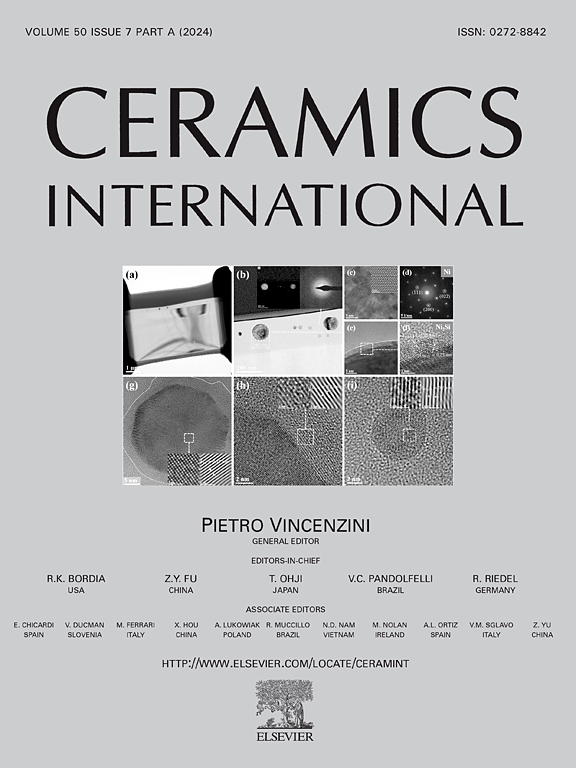Effect of phase composition and microstructure on fracture toughness and thermal conductivity of gadolinia stabilized hafnia ceramics
IF 5.6
2区 材料科学
Q1 MATERIALS SCIENCE, CERAMICS
引用次数: 0
Abstract
Due to excellent thermophysical properties, cubic (C) phase HfO2 is a promising candidate for thermal barrier coatings. Improving its fracture toughness is still a critical challenge before its engineering application. In this study, we proposed a phase-engineering strategy by incorporating the monoclinic (M) phase into the cubic (C) matrix to improve fracture toughness. A series of GdO1.5-doped HfO2 ceramics, with general chemical formula GdxHf1-xO2-x/2 (0≤x ≤ 0.20), were prepared by solid-state sintering at 1600 °C. Dual-phase M + C composite ceramics were obtained when 0 < x < 0.2. Notably, a percolation-like cluster structure was generated when M phase content reached 35 vol%. In which the M phase formed percolating interconnected network inside the C phase matrix. This unique architecture enabled a remarkable 90 % enhancement in fracture toughness, reaching a maximum value of 2.46 MPa m1/2 for Gd0.14Hf0.86O1.93. Additionally, Gd0.14Hf0.86O1.93 also maintained a relatively low thermal conductivity (2.0 W m−1 K−1 at 1200 °C), and the percolation-like clusters block radiative transport at high temperatures, resulting in thermal conductivities of the composite ceramics remaining constant. These findings demonstrate a synergistic approach to enhance mechanical durability and thermal insulation performance in advanced TBC materials, offering valuable insights for next-generation high-temperature applications.
相组成和显微组织对钆稳定铪陶瓷断裂韧性和导热性的影响
立方(C)相HfO2具有优异的热物理性能,是热障涂层的理想材料。在其工程应用之前,提高其断裂韧性仍然是一个关键的挑战。在这项研究中,我们提出了一种相工程策略,将单斜相(M)纳入立方(C)基体中,以提高断裂韧性。采用1600℃固相烧结法制备了一系列gdo1.5掺杂HfO2陶瓷,其化学通式为GdxHf1-xO2-x/2(0≤x≤0.20)。当0 <时得到双相M + C复合陶瓷;x & lt;0.2. 值得注意的是,当M相含量达到35 vol%时,形成了类似渗滤的团簇结构。其中M相在C相基体内部形成渗透互联网络。这种独特的结构使断裂韧性提高了90%,当Gd0.14Hf0.86O1.93时达到2.46 MPa m1/2的最大值。此外,Gd0.14Hf0.86O1.93也保持了相对较低的导热系数(在1200℃时为2.0 W m−1 K−1),并且在高温下,类似渗滤的团簇阻挡了辐射输移,导致复合陶瓷的导热系数保持不变。这些发现展示了一种协同方法,可以提高先进TBC材料的机械耐久性和隔热性能,为下一代高温应用提供了有价值的见解。
本文章由计算机程序翻译,如有差异,请以英文原文为准。
求助全文
约1分钟内获得全文
求助全文
来源期刊

Ceramics International
工程技术-材料科学:硅酸盐
CiteScore
9.40
自引率
15.40%
发文量
4558
审稿时长
25 days
期刊介绍:
Ceramics International covers the science of advanced ceramic materials. The journal encourages contributions that demonstrate how an understanding of the basic chemical and physical phenomena may direct materials design and stimulate ideas for new or improved processing techniques, in order to obtain materials with desired structural features and properties.
Ceramics International covers oxide and non-oxide ceramics, functional glasses, glass ceramics, amorphous inorganic non-metallic materials (and their combinations with metal and organic materials), in the form of particulates, dense or porous bodies, thin/thick films and laminated, graded and composite structures. Process related topics such as ceramic-ceramic joints or joining ceramics with dissimilar materials, as well as surface finishing and conditioning are also covered. Besides traditional processing techniques, manufacturing routes of interest include innovative procedures benefiting from externally applied stresses, electromagnetic fields and energetic beams, as well as top-down and self-assembly nanotechnology approaches. In addition, the journal welcomes submissions on bio-inspired and bio-enabled materials designs, experimentally validated multi scale modelling and simulation for materials design, and the use of the most advanced chemical and physical characterization techniques of structure, properties and behaviour.
Technologically relevant low-dimensional systems are a particular focus of Ceramics International. These include 0, 1 and 2-D nanomaterials (also covering CNTs, graphene and related materials, and diamond-like carbons), their nanocomposites, as well as nano-hybrids and hierarchical multifunctional nanostructures that might integrate molecular, biological and electronic components.
 求助内容:
求助内容: 应助结果提醒方式:
应助结果提醒方式:


